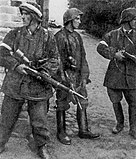| Operation Tempest | |||||||
|---|---|---|---|---|---|---|---|
| Part of Eastern Front and World War II | |||||||
 Polish soldiers during the Warsaw Uprising. | |||||||
| |||||||
| Belligerents | |||||||
|
| |||||||
| Commanders and leaders | |||||||
|
Hans Frank Erich von dem Bach-Zelewski |
Tadeusz Bór-Komorowski Leopold Okulicki | ||||||
| Part of a series on the |
| Polish Underground State |
|---|
 |

Operation Tempest (Polish: akcja „Burza”, sometimes referred to in English as "Operation Storm") was a series of uprisings conducted during World War II against occupying German forces by the Polish Home Army (Armia Krajowa, abbreviated AK), the dominant force in the Polish resistance.
Operation Tempest's objective was to seize control of German-occupied cities and areas while the Germans were preparing their defenses against the advancing Soviet Red Army. The Polish Underground State hoped to take power before the Soviets arrived.
A goal of the Polish government-in-exile in London was to restore Poland's 1939 borders with the USSR, rejecting the Curzon Line border. According to Jan Ciechanowski,
"The [exiled] Polish Cabinet believed that by refusing to accept the Curzon Line they were defending their country's right to exist as a national entity. They were determined that Russo-Polish relations should be restored on the basis of the pre-1939 territorial arrangements."[1]
- ^ Jan. M. Ciechanowski. The Warsaw Rising of 1944. Cambridge University Press. Cambridge. London. 1974. p.9